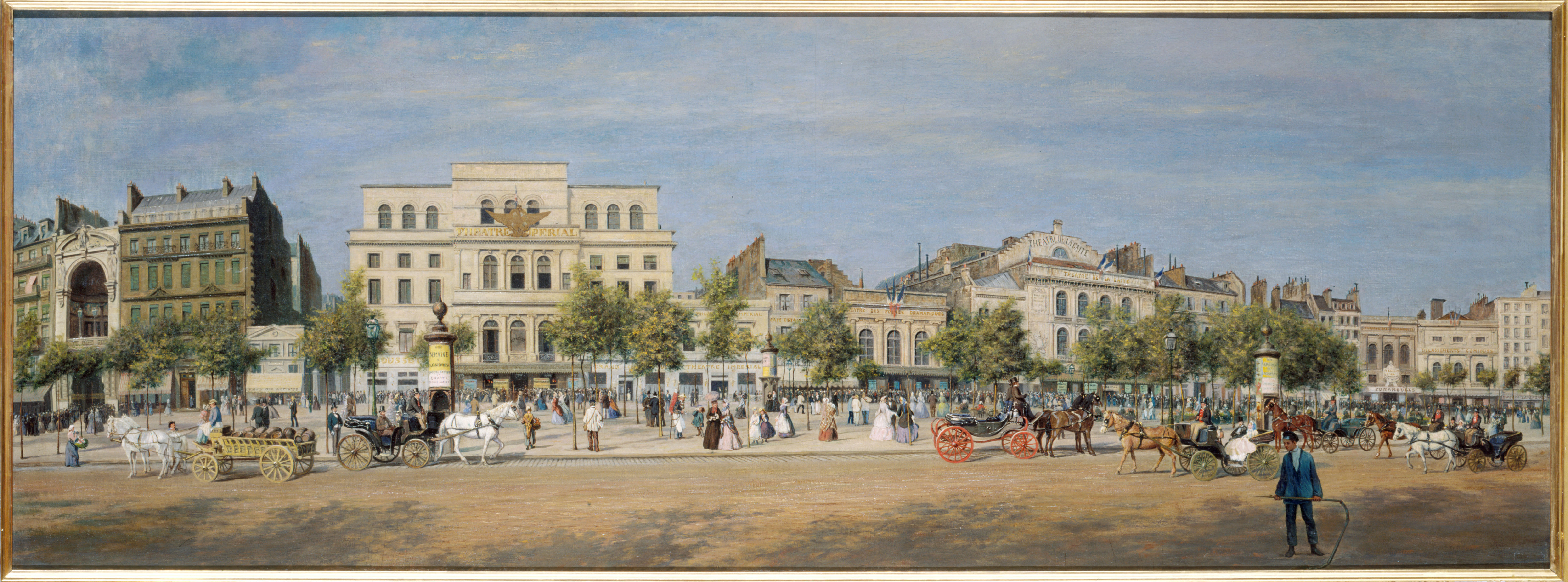Boulevard du Crime on:
[Wikipedia]
[Google]
[Amazon]
 The Boulevard du Crime was the nickname given in the 19th century to the
The Boulevard du Crime was the nickname given in the 19th century to the
MSN Encarta: Théâtre des Funambules
/ref> * the Théâtre de la Gaîté * the
''Le Boulevard du crime'' by Mario Proth, Balitout-Questroy and Co., Paris, 1872
{{DEFAULTSORT:Boulevard du Crime 11th arrondissement of Paris
Boulevard du Temple
The Boulevard du Temple, formerly nicknamed the "Boulevard du Crime", is a thoroughfare in Paris that separates the 3rd arrondissement from the 11th. It runs from the Place de la République to the Place Pasdeloup, and its name refers to the ne ...
in Paris because of the many crime melodramas that were shown every night in its many theaters. It is notorious in French history for having lost so many theatres during the rebuilding of Paris by Baron Haussmann
Baron is a rank of nobility or title of honour, often hereditary, in various European countries, either current or historical. The female equivalent is baroness. Typically, the title denotes an aristocrat who ranks higher than a lord or knigh ...
in 1862. Of the theatres on the boulevard, only the Folies-Mayer escaped demolition during the construction of Place de la République
The Place de la République (known as the Place du Château d'Eau until 1879) is a square in Paris, located on the border between the 3rd, 10th and 11th arrondissements. The square has an area of .Warner, p. 250 Named after the First, Second an ...
—solely because it was on the opposite side of the street.
In spite of the name, the "Boulevard of Crime" was not dangerous or unpleasant. In fact, it was one of the most popular places in Paris. Every night more than 20,000 people came to walk, sing, laugh and have fun.
The "Boulevard du Crime" is featured in the 1945 film '' Children of Paradise'' directed by Marcel Carné and gives its name to the first of two sections of the film.
Theaters on Boulevard du Crime demolished in the great reorganization of 1862
* theThéâtre Lyrique
The Théâtre Lyrique was one of four opera companies performing in Paris during the middle of the 19th century (the other three being the Opéra, the Opéra-Comique, and the Théâtre-Italien). The company was founded in 1847 as the Opér ...
* the Cirque Olympique
* the Théâtre des Folies-Dramatiques
The Théâtre des Folies-Dramatiques was a theatre in Paris in the 19th and 20th centuries. Opened first in 1832 in the site of the old Théâtre de l'Ambigu-Comique on the Boulevard du Temple, under Frédérick Lemaître it became a noted venue f ...
* the Théâtre des Funambules
The Théâtre des Funambules ('The Theatre of the Tightrope-Walkers') was a former theater located on the boulevard du Temple in Paris, sometimes called the Boulevard du Crime. It was located between the prominent Théâtre de la Gaîté, and th ...
/ref> * the Théâtre de la Gaîté * the
Théâtre des Délassements-Comiques Théâtre des Délassements-Comiques is a name that was used for a number of different theatres in Paris from 1785 to 1890.
First (boulevard du Temple, 1785–1799)
The first Délassements-Comiques was a small theatre on the boulevard du Temple, ...
* the Théâtre des Associés (renamed Theatre Patriotic under the Revolution, and Théâtre de Mme Saqui)
* the Théâtre des Pygmées
* the Petit-Lazare
* many other cabarets and cafés
References
External links
''Le Boulevard du crime'' by Mario Proth, Balitout-Questroy and Co., Paris, 1872
{{DEFAULTSORT:Boulevard du Crime 11th arrondissement of Paris
Crime
In ordinary language, a crime is an unlawful act punishable by a state or other authority. The term ''crime'' does not, in modern criminal law, have any simple and universally accepted definition,Farmer, Lindsay: "Crime, definitions of", in Ca ...
Former theatres in Paris